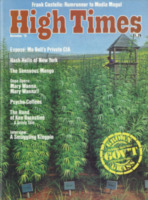HIGH TIMES
The Magazine of High Society.
[#17598]
Numbers 1-76. Summer 1974 - December 1981. In the original coloured wrappers, overall condition is excellent with some issues "like new" and others with only minor reading wear. Front and back covers all intact and fine (except for a rubberstamp on no.16 and an old mailing label on no 55;small ink mark on no 60; one spine split). The first in the premiere edition, First state with $1.00 price and "premiere issue" on the cover (grey and blue-green colored pictorial wrappers) A very rare ongoing set of the earliest period.
Editor: Ed Dwyer. From the announcement-letter (May 16, 1974): "The Trans-High Corporation of New York announced today the publication of a new magazine.... It offers extensive and sophisticated coverage of the pleasure and psychochemical culture.... articles ranging from the ecology of cannabis paper to an investigative report on a nine-ton pot bust. ...A regular feature of High Times is a comprehensive Wall Street Journal-type listing of psychochemical prices around the world (=in fact 'High Witness News'). ..Also featured are medical and legal columns written by leading experts as well as eclectic reviews of films, records and books. ... psychochemicals have become the cause of psychological and sociological problems; to alleviate these problems, the first step is to take a more thorough look. This is the purpose of High Times." Contribs. by Richard Ashley, Bruce Eisner, Albert Goldman, Michael Horowitz, Ron Rosenbaum, John Wilcock, Deanne Stillman, a.o. Also interviews with (o.a.) the Dalai Lama, Albert Hofmann, Dr. Norman Zinberg, Andy Warhol, Peter Beard, Fran Lebowitz, Keith Richard, Marianne Faithfull, etc. In addition to the controversial drug coverage and in-depth countercultural articles, there is a sizeable amount of early punk rock coverage thanks to Tom Forcade's early interest in the Sex Pistols and punk music as the "next big thing". Forcade even provided funding for John Holmstrom's Punk magazine at one point. While High Times continues to this day, the focus here was on music related coverage and therefore this particular run ends in 1981 where the musical interest also begins to taper off.
More images:





